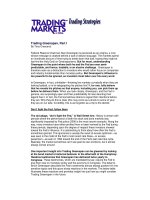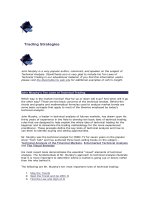Tài liệu Trading the Indicators: Be Your Own Analyst: Understanding Volume pdf
Bạn đang xem bản rút gọn của tài liệu. Xem và tải ngay bản đầy đủ của tài liệu tại đây (37.13 KB, 6 trang )
Trading the Indicators: Be Your Own Analyst:
Understanding Volume
Trading the Indicators: Be Your Own Analyst: Understanding Volumeby: Kira
McCaffrey Brecht
Many technical traders will tell you that price is king. Everything comes down to price,
and price is the most important indicator in and of itself. Experienced traders know that
many technical indicators are simply price massaged, oiled and spit out into a fancy blue
or red line at the bottom of one’s chart. But volume is a completely different animal.
While you’d have to travel far and wide before you’d chance upon a trader who would
say that volume readings are more important than price, they are useful and significant
raw data readings that measure the amount of action and psychology of the market
players.
Volume, of course, simply is the measure of the number of shares of Intel or Qualcomm
or any stock traded during a day. In the futures arena, volume measures how many corn
contracts or S&P E-minis changed hands that session. For those who are trading on an
intraday basis, 5-minute volume bars can be found, or for traders more comfortable with
a longer-term view, weekly or monthly volume data can be called up just as easily.
Newton’s Law
Remember back to high school physics. Newton’s first law of motion reflects the concept
underlying volume analysis in the financial markets. This law says that an object in
motion will stay in motion unless acted upon by an unbalanced force.
Thus, many technical traders call volume the fuel behind a market move. Is the gas tank
full and providing powerful momentum for that Porsche speeding down the Autobahn?
Or is the gas tank nearing empty, which means the engine is likely sputtering, and the
driving machine is slowing and limping toward the shoulder of the road? For a trader
who is looking to put on a stock trade from the long side, knowing how much gas is
likely left in the tank is an important variable. After all, how many smart drivers set off
for a long trip with only a gallon of gas left in the tank?
Joe Granville, editor of the Granville Market Letter and developer of the popular volume
tool called on balance volume (OBV) [we’ll get to this later…], puts it another way and
says that volume “is the steam in the boiler that makes the Choo Choo go down the
tracks.”
Use It to Confirm
“Generally speaking, volume has to confirm price,” explains John Murphy, author and
chief technician at Stockcharts.com. “When price breaks out to the upside [or downside],
we normally like to see a nice pickup in volume to confirm that.”
One of the basic rules of thumb for traditional volume analysis is that a healthy uptrend
would see expanding volume on up days and contracting volume on down days. Just the
opposite would be true for a downtrend. “When you get an exception to that, it can be a
sign that trend is changing,” says Phil Roth, chief technical analyst at Miller Tabak & Co.
Daily volume data is easy to find and can even be tracked via the Wall Street Journal, and
most charting software packages offer an option for volume bars across the bottom of the
chart.
“A market rallying on light volume is a sign there isn’t as much bullishness. It is a
hesitant market,” says Murphy. “When we don’t get volume, we get more suspicious.”
Or another subtlety for which to be on the lookout is “big volume in an uptrend, but no
price progress. That could be a signal that you’ve hit resistance,” adds Roth. The idea is
that an unusual change in a volume pattern could signify a possible reversal.
More Rules of Thumb
Some other basic rules of thumb in relation to volume are that bull markets tend to have
bigger volume, while bear markets tend to have lighter volume. “Markets must be pushed
up but can sink on their own weight,” notes Roth. In a downtrend, traders would like to
see increasing volume on down days and decreasing volume on up days.
Brian Shannon, director of research at Marketwise uses volume in his trading and
analysis. He says “volume is second only to price. Price is what pays, and volume lets us
know about the emotional condition of the buyers and sellers.”
Shannon highlights a couple of his favorite reflections on volume:
•
Big volume without further upside equals distribution;
•
Big volume without further downside equals accumulation;
•
Volume tends to peak at turning points;
•
Volume often precedes price movement;
•
Volume is a relative study.
Shannon outlines an example for a stock that is rallying. "You'd like to see that stock
advancing on increasing volume each day, say 600,000 the first day, a million the second
day and a million-five the third day. Price pullbacks should see successively lower
volume, such as 900,000, 600,000 then 450,000" to reflect a healthy advance.
One of the old market adages says that once a trend is established, it is more likely to
continue than to reverse. "That is even more likely to be true if pullbacks are on declining
volume," says Shannon. For traders who may have missed an entry opportunity on a
breakout, if a stock posts a retreat on declining volume, that may offer a second entry
opportunity for a trend move.
Divergence
Themes that come up over and over again in the field of technical analysis are the
concepts of confirmation and divergence. Divergence often is used in the world of
oscillator readings with such tools as stochastics or the relative strength index. Simply,
the idea with those tools is that with a bullish trend, one should see rising oscillator
readings. When that doesn’t occur, a divergence occurs, and that is an important “red
flag” warning signal that trend could be about to change. Example? – if a price made a
new high in an uptrend, but stochastics failed to make a new oscillator high and actually
turned lower. That would represent a bearish divergence.
Take that concept and apply the same principle to volume. For example, in a bull trend,
does a stock or a commodity price hit a new high for the rally move, but declining
volume is seen for that session? Red flag time.
Blow ff and Climax
Now for the exciting stuff: blow-offs and climaxes. Blow-offs tend to occur at major
market peaks, while climaxes emerge at market bottoms. These terms simply reflect a
huge amount of volume that emerges late in a market rally (or decline) with a sudden
peak. Prices then abruptly reverse.
“Volume tells me where the action is. It shows me the collective psychology of the
participants if they are fearful or overly optimistic,” says Shannon. However, “it’s tough
to say what a climax or blow-off is until after it is over.”
Confirm Pattern Breakouts
Another use of volume analysis is to incorporate volume readings along with pattern
breakouts. For those schooled in traditional pattern analysis, volume can be a helpful
confirming indicator for double bottom or top, flag, triangle or any type of pattern
breakout. How does it work? Jordan Kotick, global head of technical analysis at
Barclay’s Capital says that for him, “Volume shows conviction. Is there conviction in a
move?”
Combining a price breakout with a volume confirmation simply helps a trader to see if
there is conviction behind that price breakout. Let’s say that corn futures have been in a
downtrend. But because markets don’t ever simply go straight up or down, the bear trend
takes a pause, prices consolidate for several weeks, and a continuation triangle develops
on the daily chart. Then one day, traders wake up and corn breaks out to the downside of
that triangle, blasting below the lower triangle line at the final bell. On that day, traders
could look for a high-volume day, a large and long volume bar, relative to the recent
sessions. A high-volume day would be viewed as “confirmation” to the downside
breakout of that pattern.
Drill a Little Deeper
For those wanting to take volume analysis to the next step, traders could study what is
called upside volume, versus downside volume, when analyzing the major U.S. stock
averages. Just as it sounds, the upside/downside ratio simply reveals the relationship
between the total volume of advancing shares, versus the total volume of declining
issues.
On Balance Volume
There are a variety of tools and ratios based on volume, but one of the early volume
indicators, developed by Joe Granville in the early 1960s, is known as OBV. This tool
can help traders avoid the subjective nature of “eyeballing” those volume bars streaming
across the bottom of the chart. (Is that one slightly bigger or smaller?) The OBV indicator
turns the volume data into a line graph, which can be displayed across the bottom of
one’s chart. Traders actually can draw trendlines on the OBV indicator just like a price
chart. When the OBV turns and breaks that trendline, it can signal a potential turning
point in price. It also can be used like an oscillator to help pinpoint divergences between
price highs and volume peaks or price lows and volume troughs.
“If price is moving up, OBV should be moving up, too,” explains Murphy. He also notes
that OBV could actually be a leading indicator. “OBV can break out before the stock
does,” Murphy says.
The calculation behind the OBV is extremely easy to understand even for those who are
as math-challenged as this author. The total volume for a session is given a plus or minus
value depending on whether prices closed higher or lower that day. A higher close would
result in the volume to be counted as a “plus,” while a lower close would result in a
“minus” value. Thus, a running total is achieved by simply adding or subtracting volume
depending on direction of the market close.
For those who are just beginning to use volume as part of their analysis and trading,
Granville advises students to “pick a stock, preferably a well-known stock. Follow it
every day in the newspaper. Keep a running total of volume. If it closes up, add all the
volume of the stock traded that day. If it closes down, subtract the volume of that day
from the previous figure. You’ll see a running commentary on the action of the stock.
You’ll see the evidence that volume precedes the price trend.”
Equivolume Charts
Volume analysis has spawned a range of indicators and even a new type of charting
technique, called equivolume bars. This type of chart actually combines price and volume
into one bar or box. For those familiar with Japanese candlestick charts, the concept is
somewhat similar. Basically, the top of the equivolume box represents the day’s price
high, while the low is seen at the bottom of the box. The width of the box represents the
day’s volume. The wider the box, the heavier the volume during that session. “By just
glancing at the bars, you can tell which days have heavier volume,” explains Murphy.
Add Open Interest to the Mix
Traditionally, some technical analysts have combined volume with the study of open
interest, which simply refers to the number of outstanding contracts still open at the end
of the trading day in the futures markets. With the advent of 24-hour markets and the rise
in popularity of foreign exchange trading among individual traders, the study of open
interest appears to have waned somewhat. But for those wanting to understand the basic
rules of thumb, they still apply.
Traditional Open Interest and Volume Guidelines:
•
If prices are rising and volume and open interest are increasing, it represents a
strong market;
•
If prices are rising while volume and open interest are falling, it reveals a
weakening market;
•
If prices are falling while volume and open interest are increasing, it represents a
weak market;
•
If prices are falling while volume and open interest are falling, it represents a
strong market.
Don’t Make This Mistake
According to Marketwise’s Shannon, one of the biggest misuses of volume is an
interpretation when a stock is declining. Let’s say a trader is long a stock and price begins
to pull back. “People convince themselves to hold on because it [the pullback] is on light
volume,” Shannon says. But that may not be the best way to manage a trade. “Would you
rather lose ten percent of your money on light volume or big volume?” asks Shannon. He
instead advises traders to exit a position “based on price action.”
Another common mistake is that many traders could point to a heavy volume day and be
convinced that it is a climax or blow-off day. “Most people end up misreading big
volume,” says Shannon. “Just because it is the biggest volume in three days, doesn’t
mean the move is over. Volume could be even bigger the next day.”
Timing Is Everything
Typically, trading in the stock market (and the futures on the major stock indexes) sees
the heaviest volume during the first hour-and-a-half of the day and then the last hour-and-
a-half of the day. Traders can use this generality to help them in their intraday trading.
“The midday doldrums occur because institutional traders are waiting you out,” warns
Shannon. Often times, major institutional players will execute large portions of orders in
the morning, and then wait for heavy volume and renewed trending action late in the day
to finish orders.
This can be helpful information for those who are trading very short term on an intraday
basis. “If you are a hyperactive trader and have to take your profits, take them during the
first move in the morning,” says Shannon. There may be another opportunity during the
second late-day wave of action. Otherwise a trader who bought, say, the S&P E-mini
early in the day and saw some profits in that trade, may slowly watch that profit erode
during the lunchtime doldrums, as prices simply tick slowly lower. For those who get
spooked on pullbacks or don’t have the patience to wait for the afternoon move, it may be
wise to simply book the profits early on.
Closing Thoughts
Here are a few more tidbits on incorporating volume into your trading and analysis.
Use volume simply as a screening tool. For those who are scanning thousands of stocks
looking for a good trading opportunity, volume can help distinguish between those that
are in an uptrend or downtrend (depending on whether one is looking for long or short









